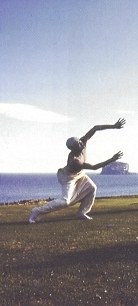

What does Butoh mean?
Butô, the original Japanese contribution to modern dance, arose during the 1960s. Today, Butô enjoys an extraordinarily high level of popularity worldwide. Founded by Tatsumi Hijikata, this innovative genre is currently being preserved and evolved by dance groups like Sankai Juku and Byakkosha and by soloists like Kazuo Ono.
The following is an excerpt from a statement by Ushio Amagatsu, the leader of the Sankai Juku Group. "Bu means 'to dance' and tô means 'to stamp the ground.' In the traditional sense, butô is a ritual dance performed by farmers when they celebrate the harvest. On the other hand, butô is also a revolutionary movement in the dance world of the 1960s.... Butô is the cycle between birth and death, life and death. In its own unique way, butô dance connects centuries-old East Asian corporeal wisdom with the European search for personal identity. Butô is a paradoxical process of self-oblivion and self-realization.
Butô dance has a spiritual dimension and butô has to do with life itself. It's a living sign in space. Many decades ago, the Japanese avant-garde had already found its way to Europe."
Parts of an interview with Amagatsu and Alexandra Paszkowska
A.P.: What does Buto mean?
AMAGATSU: "BU" means dance, "TÔ" means stamp on the ground.
Traditionaly it´s a ritual dance. Buto is danced by the peasants during the harvest festival. On the other hand, Buto arose during the '60's as a revolutionary movement, a counter-movement to Buto dancing. Buto is mixture of modern and classical japanese dance. To express a return to the roots of human-kind word Buto was used in contrast to Buyo. There are various definitions for Buto, and what I' am saying now is only my personal opinion. Buto is the circle of birth, life and death as expressed trough theatre. I get my ideas from every-day life. My theatre always comes from a definite position about life, from what life means to me.
A.P.: How is traditional Japanese dance different?
AMAGATSU: I can learn a lot from classical dances like Kabuki and No. They are very valuable. On the other hand, trying to imitate them outwardly is meaningless for me. I feel obliged to create my own dance within the context of a contemporary situation, both socially and politically. Each and every time I have to understand it anew and express it. Kabuki and No were also new creations once, an avant-garde. We can learn a lot from them, for example, the creative process.
One thing we shouldn't forget: all human creations have historical reasons for coming about. I should add too that the characters in our Japanese script all have a separate meaning.
A.P.: I'am interested in the meaning of your gestures.
AMAGATSU: There isn't always a definite, unchanging meaning for individual gestures. It's impossibile to analyse the elements of dance separately from each other, in the same way one can't explain a completed painting analytically. A verbal explanation usually destroys the impression and limits the real effect.
When people see my performance, I don't want to come with a pre-fabricated opinion. I want them to see not only with their eyes, but with their whole being.
Butô's themes include the ambivalence of light and darkness, birth and death, arisal and decay. It stages rites of mystery, torture and nightmare, followed by awakening, salvation, springtime and sheer awe in the encounter with the beauty of being itself.
Sankai Juku was founded in 1975 by Ushio Amagatsu, who belonged to the first generation of butô dancers. Even in its earliest performances, Sankai Juku already imbued the genre of butô dance with a new transparency and an unprecedented clarity. The power of individual expression broke through traditional Japanese stylization to create an impassioned pageant of life and death. The name "Sankai Juku" means "School of Mountain and Ocean."
Since 1978, Sankai Juku has performed at major festivals around the world (e.g. in Nancy, Avignon) and at other important events (e.g. the Olympic Games in Los Angeles).
Links
|
|
 |
